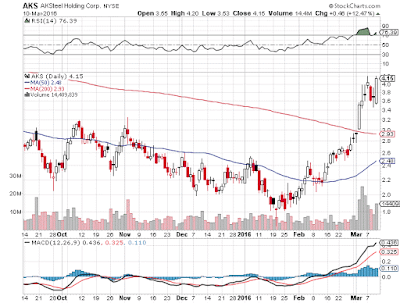Some of the oil-correlated commodity stocks do look like they are setting up for higher though, like $PBR and $BTU. $BTU showed impressive volume today as a follow-up day to yesterday's earnings release. It wasn't bad for a day 2 move, and my ATR/3 formula would have helped you safely score 60 cents without overstaying your welcome if you bought it any price under $6.52, which is awesome considering the almost-parabolic move off the lows in the morning. Speaking of that, Nate Michaud bought into $BTU on that morning washout and crushed the stock for $1.25 a share on some of his sells, which comes out to like 20% on one trade. I don't trade the morning washouts myself, but I definitely want to track the setup going forward. I think I might demotrade it or use small size until I can figure out the factors that further increase the probability of that setup.
Now onto the main focus of today's post: the sector move in steel.
I suspected this would happen when $X held up really well in the decline of the last few days. The stock is now surging upward, almost breaking out of the multi-day high at $14.54.
$AKS followed as well, almost breaking out of $4.20.
You can see the extreme imbalance of buyers versus sellers. In one day these two stocks moved all the way from the bottom of their range to the top. The price action was so strong that I couldn't help but start accumulating (my initial buy on $X was 13.75) before the breakout even occurred (gasp!) for an overnight hold.
I felt comfortable doing it since the setup is such a high EV trade. When trades like this come around, I like to cheat the breakout a bit to give me some cushion to really swing big size at the breakout. It's unique to my trading style and lets me capture huge returns on these special setups since the shares at the lower price bring down my average share price. I am never red on the position and don't get shaken out if the stock pauses and consolidates a bit above the breakout level.
My plan is to plow my entire account into $X on the breakout, which will likely happen at the open. That's another reason why I love $X and $AKS, as well as some of the other institutional commodity stocks in general. Their floats are so thick compared to their daily traded volume (which is also pretty high) that they don't gap much, if at all. It allows most of a big move get captured by day traders, as opposed to gaping up $5 overnight to reward people holding overnight. They're also so liquid when they make these moves - you could comfortably trade $2-4 million dollars worth of shares in $X alone without pushing the price around that much. Not to mention you could hold about half a million in $AKS.
Although the rest of the steel stocks like $RS, $ATI, and $NUE are moving up as a group and have better fundamentals, $X and $AKS are putting in the biggest moves. I finally figured out why today:
As of 3/1/2016
$X short interest: 52M shares
Today's volume: 29M shares
$AKS short interest: 40M shares
Today's volume: 14M shares
These short shares are only about 25-35% of each respective float. But they're massive compared to how much volume these stocks are trading, and keep in mind they both did 255% of average volume today. These short sellers are locked short. They couldn't all possibly get out of the stock in a single day, even if they wanted to.
It's like starting a fire in a crowded theater when there's only one small, narrow exit.
These stocks are likely to rip higher tomorrow, and may even put in continuation moves the following day. The price action is very similar to solars like $CSIQ and $SPWR years back, with the reward/risk heavily skewed in favor of upside. I could see $X and $AKS doubling (possibly even tripling for $AKS) before all is said and done.
I don't know if the highest EV move in the short term will be to just blind hold though. These stocks are now trading on hype and anticipation of the USDOC tariff decision on hot-rolled steel to come out on March 14. Since we're now trading in anticipation, there's no real way to predict the decision or even how the stock will react to the decision. From a logical standpoint, the hot-rolled steel decision should theoretically be less impactful than the cold-rolled steel decision. Hot-rolled steel is cheaper, lower margin steel and the case does not involve China, who made up a massive portion of the total cold-rolled market and was given a country-wide 265% import duty since none of the Chinese companies responded. If the hot-rolled steel case involved China, this would be a total no-brainer slam dunk -- why would these Chinese companies respond now when they didn't for the cold-rolled decision?
The safest, most predictable profit would be to buy the breakout and sell prior to the close. But is that the highest EV outcome? I don't know...



No comments:
Post a Comment